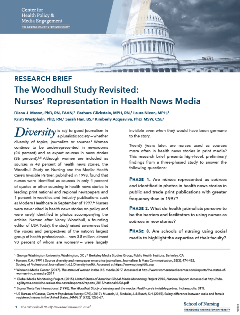On Tuesday, 8 May 2018, researchers presented preliminary findings from the Woodhull Study Revisited: Nurses’ Representation in Health News Media, sponsored in part by Sigma.
 This three-phase study sought to replicate the original Woodhull Study that examined journalists’ use of nurses as sources in leading print media of the day. The updated study also included an analysis of tweets from the top 50 schools of nursing. The preliminary findings show that, two decades after the original Woodhull Study, little has changed.
This three-phase study sought to replicate the original Woodhull Study that examined journalists’ use of nurses as sources in leading print media of the day. The updated study also included an analysis of tweets from the top 50 schools of nursing. The preliminary findings show that, two decades after the original Woodhull Study, little has changed.
According to the preliminary report, “In 1997, nurses appeared as sources in 4 percent of daily newspaper articles and in 1 percent of articles in weekly and industry publications. In 2017 nurses were quoted in 2 percent of newspaper articles and in 1 percent of articles in weekly and industry publications.”
The study’s authors also found that nurses were rarely identified in photographs and noted that their voices were “conspicuously absent” in discussions of health policy, the business of health care, and research. Even articles about the nursing profession used nurses as sources only 44 percent of the time. In addition, the authors noted:
- Ninety percent of nurses are women, who are statistically half as likely as men to be quoted in the media.
- When reporters call communications staff at health care organizations and universities, typically the default practice is to forward the request to a physician.
- Publication style guidelines often mandate that physicians be identified through the honorific “Dr.” while discouraging the use of credentials such as RN for other professionals. As a result, some nurses may be hidden in plain sight, with only their administrative, research, or policymaking role visible to readers.
As a sponsor of the Woodhull Study Revisited, Sigma is committed to raising the profile of nurses as thought leaders, especially in social media. Sigma regularly recognizes and disseminates information to the #NursesWhoTweet Twitter community, and has hosted workshops and presentations at the United Nations Commission on the Status of Women, Sigma’s annual International Nursing Research Congress, and its Biennial Convention.
“We are finding ways to share the findings from the Woodhull Study Revisited and educate nurses on social media and serving as a media source,” said Sigma CEO Elizabeth Madigan, PhD, RN, FAAN. “Look for exciting updates on this topic as we prepare for upcoming Sigma events and education opportunities.”
For additional information on findings from the Woodhull Study Revisited, visit the Woodhull Study Revisited website hosted by George Washington University. A complete version of the original study is available on the Sigma Repository.